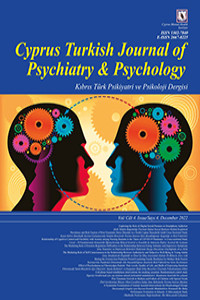Fibromiyalji Tanılı Bireylerin Ağrı Düzeyleri, Yaşam Kaliteleri ve Duyguları İfade Etme Becerileri Üzerinde Psikodramanın Etkisi
Abstract
Bu araştırmada FMS hastalarında psikodrama grup psikoterapisinin etkililiğinin sınanması ve üyelerin FMS’nin psikolojik kökenleri hakkında farkındalık geliştirmeleri, duygularını ifade etme becerileri kazanmaları ve yaşam kalitelerinin artması hedeflenmiştir. Bu araştırma, psikodrama oturumlarına katılan FMS tanılı 9 kadın üye ile gerçekleştirilen kontrol grupsuz deneysel desenli bir araştırmadır. Araştırmanın bulguları için Kişisel Bilgi Formu, SF-36 Yaşam Kalitesi Ölçeği, Visüel Analog Skala (VAS), Duyguları İfade Etme Ölçeği (DİEÖ) kullanılmış ve non-parametrik ölçümler yapılmış ve elde edilen verilere göre grubun ön test ve son test puanları arasında istatistiksel olarak anlamlı bir fark gözlenmiştir. Grup üyelerinin psikodrama oturumları sonunda, öncesine göre görsel ağrı analog düzeylerinde azalma gözlenirken yaşam kalitesi ve bunun alt boyutları olan fiziksel, sosyal işlevlerde ve rollerde, mental sağlık, canlılık ve genel sağlık algısında ve duygularını ifade etme becerilerinde pozitif yönde anlamlı artış tespit edilmiştir. Sonuç olarak, psikodrama oturumları sonunda FMS’li üyelerin ağrıları azalırken, duygularını ifade etme becerileri ve genel yaşam kaliteleri artmıştır.
References
- Friedberg, F. (2010) Chronic fatigue syndrome, fibromyalgia, and related illnesses: a clinical model of assessment and intervention. J Clin Psychol, 66, 641-665. https://doi.org/10.1002/jclp.20676.
- King, L. A., & Emmons, R. A. (1990). Confict over emotional expression: Psychological and physical correlates. Journal of Personality And Social Psychology, 58(5), 64-877. https://psycnet.apa.org/doi/10.1037/0022-3514.58.5.864.
- Koptagel, İ.G. (1996). Tıpsal Psikoloji: Tıpta Davranış Bilimleri. Ankara: Güneş Kitabevi.
Effect of Psychodrama on Fibromyalgia Patients’ Pain Levels, Quality of Life, and Skills of Expressing Emotions
Abstract
This study aimed to explore the effectiveness of psychodrama group psychotherapy on fibromyalgia patients and improve the physical and psycho-social well-being of patients by enabling them to develop awareness about the psychological origins of their pain, gain skills to express emotions, and externalize emotions. The study employed the experimental design without a control group. The participants consisted of nine female fibromyalgia participants who were able to continue their participation in the psychodrama sessions. The Personal Information Form, the 36-Item Short Form Health Survey, the Visual Analogue Scale, and the Emotional Expressivity Scale were administered to collect the study data, and non-parametric measurements were performed. As a result, according to the study findings, at the end of psychodrama group therapy, the pain of group members with fibromyalgia decreased, whereas their ability to express emotions and their general quality of life increased.
References
- Friedberg, F. (2010) Chronic fatigue syndrome, fibromyalgia, and related illnesses: a clinical model of assessment and intervention. J Clin Psychol, 66, 641-665. https://doi.org/10.1002/jclp.20676.
- King, L. A., & Emmons, R. A. (1990). Confict over emotional expression: Psychological and physical correlates. Journal of Personality And Social Psychology, 58(5), 64-877. https://psycnet.apa.org/doi/10.1037/0022-3514.58.5.864.
- Koptagel, İ.G. (1996). Tıpsal Psikoloji: Tıpta Davranış Bilimleri. Ankara: Güneş Kitabevi.
Details
| Primary Language | English |
|---|---|
| Subjects | Psychology |
| Journal Section | Research Articles |
| Authors | |
| Publication Date | December 20, 2022 |
| Acceptance Date | October 30, 2022 |
| Published in Issue | Year 2022 Volume: 4 Issue: 4 |


